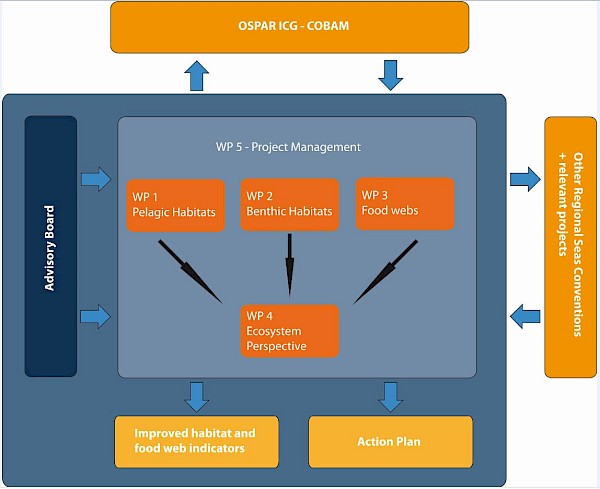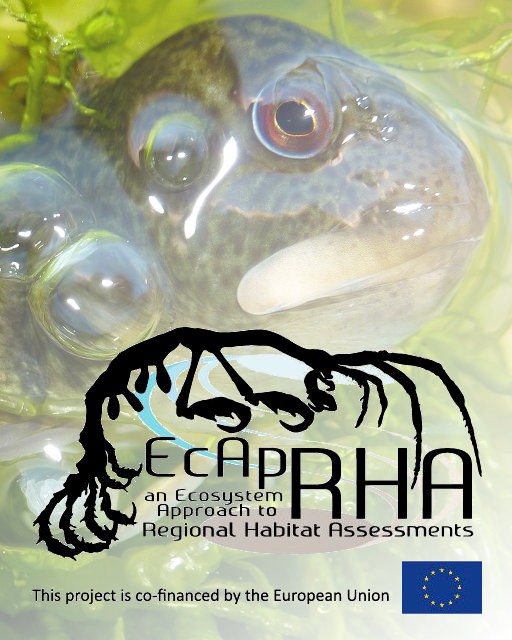About EcApRHA
Project name: “Applying an Ecosystem Approach to (sub) Regional Habitat Assessments (EcApRHA): Addressing gaps in biodiversity indicator development for the OSPAR Region from data to ecosystem assessment”
Grant number: 11.0661/2015/712630/SUB/ENVC.2 OSPAR
Project timeline: 01 December 2015 – 28 February 2017
Project budget: 940,856 Euros (714,298 EU contribution)
Advisory Board: Mark Dickey-collas (ICES), Dr Kalliopi PAGOU (ActionMed/HCMR) and BalticBOOST representatives
Partners and structure: EcApRHA has been implemented through collaboration of nine partners under the coordination of the OSPAR Secretariat. The partners are: Bioconsult, Biologie des Organismes et Ecosystèmes Aquatiques – Centre national de la recherche scientifique (BOREA-CNRS), the Centre for Environment, Fisheries and Aquaculture Science (CEFAS), Instituto Español de Oceanografía (IEO), Joint Nature Conservation Committee (JNCC), Muséum national d'histoire naturelle (MNHN), Royal Netherlands Institute for Sea Research (NIOZ), and the Sir Alister Hardy Foundation for Ocean Science (SAHFOS).

Figure 1: EcApRHA organisation
Objectives:
The EcApRHA project focused on addressing gaps in the development of biodiversity indicators for the OSPAR Regions. The project was aimed at overcoming challenges in the development of indicators[1] relating to the EU MSFD (Marine Strategy Framework Directive 56/2008/EU), Descriptor D1 (Biodiversity), D4 (Food webs) and D6 (Seafloor integrity).
Project objectives:
- To improve habitat and food web common indicator assessments to contribute to the Intermediate Assessment in 2017;
- To improve habitat and food web candidate indicators;
- To explore the potential integration and aggregation options for pelagic, benthic habitats and food webs;
- To develop an Action Plan with recommendations of how OSPAR can enable monitoring and assessment at the (sub) regional scale and increase regional coherence
Results:
The project was a good example of an effective and efficient initiative in order to progress one of the more technically challenging and least developed areas of OSPAR work.
Through EcApRHA, six common indicators and one candidate indicator (benthic, pelagic and food web) were technically improved and assessments of these indicators submitted as a contribution to the Intermediate Assessment 2017, which will support EU member states in their reporting on the EU MSFD. In addition, development of five candidate indicators have been boosted through the project, with improved technical specifications and road maps for further development, which will be delivered to OSPAR. Furthermore, the project has explored the needs, possibilities and options for indicator integration, which would be required in order to achieve ecosystem assessments and understanding of systems and functions. The project delivered technical analysis and potential proposals for further development of five integration approaches that could be applied in the OSPAR maritime area and beyond.
The development of an Action Plan was a funding requirement and is one of the main deliverables of this project. It recommends the steps to be taken by Contracting Parties in order to address the identified gaps and shortcomings in order to achieve more of an ecosystem approach (solutions and actions) and improve (sub) regionally coherent habitat assessment, monitoring and GES determination. It has been drafted in consultation with OSPAR technical expert groups as well as policy representatives. OSPAR's Biodiversity Committee (BDC) 2017 instructed ICG-COBAM to examine the Action Plan in more detail and identify how the work should be integrated into the further work of OSPAR, as well as what kind of resources might be needed in its realisation.
Table 1: Key EcApRHA project achievements
1. Support to IA 2017 | |
Indicator assessment | Support in the delivery of six common indicators and one candidate indicator assessments[2], which have been forwarded to the further IA 2017 implementation process: Deliverable 1.1 (PH1), Deliverable 1.2 (PH1, PH2 and PH3), Deliverable 1.3 (PH3), Deliverable 2.2 (BH2 and BH4), Deliverable 3.1 (FW4), Deliverable 3.2 (FW2); |
2. CEMP guidelines development | |
Indicator development | Drafting of CEMP guidelines for common and candidate indicators and further development of candidate indicators: Deliverable 2.2 (BH1, BH2, BH3 and BH4), Deliverable 3.3 (FW7), Deliverable 3.4 (FW6 and FW9) [3], including drafting the case for promotion of the candidate indicator BH1. |
3. Indicator development technical reports | |
Indicator development and assessment | Development of other technical reports in support of indicator development: Deliverable 1.1 (PH1), Deliverable 1.2 (PH1, PH2 and PH3), Deliverable 1.3 (PH3), 1.4 (PH1, PH2 and PH3), Deliverable 3.1 (FW4) and Deliverable 3.2 (FW2). |
4. Ecosystem approach towards habitat assessment (WP4): | |
Integration of indicators | Potential integration and aggregation approaches in order to achieve more coherent regional assessment of pelagic and benthic habitats and food webs; Includes technical reports (Deliverables 1.4, 2.3, 3.5 and 4.1). |
5. Action Plan | |
Identifying next steps | The Action Plan, recommending the steps to be taken by Contracting Parties to address the identified gaps and shortcomings to enable (solutions and actions) to achieve more of an ecosystem approach for (sub) regionally coherent habitat assessment (Deliverables 5.6). |
For more information about project results please see:
Other benefits and lessons
A Project evaluation exercise was conducted during the final workshop in London (9 February 2017). Participants from within the project and also from OSPAR identified a number of successes, challenges and suggestions for future projects where identified. This was reported as part of the workshop and can be found here: Final EcApRHA Workshop Report
Also, the project created opportunities for direct science and policy interactions. During three of the project workshops various OSPAR project stakeholders were invited and participated in advising and steering projects work. This included delegates from BDC, EIHA, ICG-C, ICG-COBAM and ICG-MSFD. Their involvement was incredibly valuable in ensuring that the project deliverables were “fit for OSPAR purposes”.
[1] The OSPAR common indicators that were improved by this project include: PH1 (Changes of plankton functional types (life form) index Ratio), PH2 (Plankton biomass and/or abundance), PH3 (Changes in biodiversity index), BH1 (Typical species composition), BH2 (Multi-metric indices), BH3 (Physical damage habitats), BH4 (Area of habitat loss), FW2 (Production of phytoplankton), FW4 (Changes in average trophic level) applied to bentho-demersal data, FW6 (Zooplankton community size structure in relation to biomass/abundance), FW7 (biomass and abundance of functional groups) applied to benthic and pelagic data, FW9 (Ecological Network Analysis)
[2] The OSPAR common indicators forwarded within the EcApRHA project: PH1/FW5 (Changes of plankton functional types (life form) index Ratio), PH2 (Plankton biomass and/or abundance), PH3 (Changes in biodiversity index), BH2 (Multi-metric indices), BH3 (Physical damage habitats), FW4 (Changes in average trophic level)
[3] The OSPAR candidate indicators forwarded within the EcApRHA project: BH1 (Typical species composition), BH4 (Area of habitat loss), FW2 (Production of phytoplankton), FW6 (Zooplankton community size structure in relation to biomass/abundance), FW7 (biomass and abundance of functional groups) and FW9 (Ecological Network Analysis)

